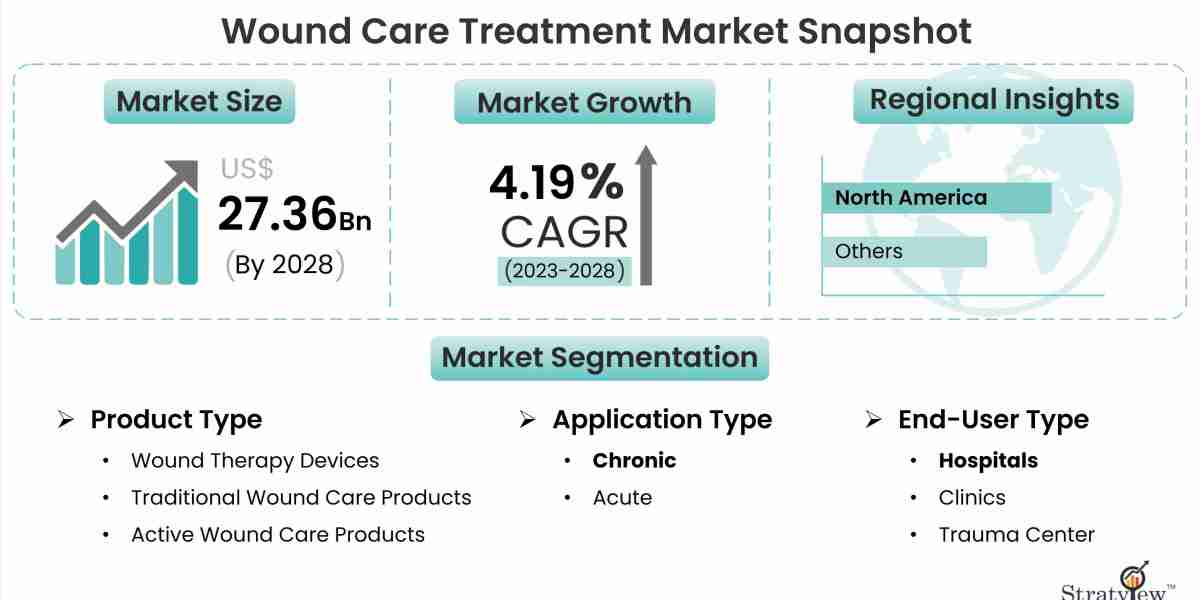Introduction
Wound healing is a complex process that has significant advancements in recent years, thanks to the continuous evolution of wound care technologies. These innovations have revolutionized the field of wound healing, offering improved treatment options, faster healing times, and enhanced patient outcomes. In this article, we explore some of the remarkable advances in wound care technologies that are transforming the way we approach wound healing.
According to Stratview Research, the Wound Care Treatment Market is expected to reach USD 27.36 billion by 2028 from USD 21.33 billion in 2022 at a healthy CAGR of 4.19% during the forecast period of 2023-2028 .
Negative Pressure Wound Therapy (NPWT)
Negative Pressure Wound Therapy, commonly known as NPWT, is a revolutionary technique that accelerates wound healing by applying controlled negative pressure to the wound bed. NPWT promotes contraction, removes excess fluid, and blood flow, which aids in tissue regeneration. The development of portable NPWT devices has made this therapy more accessible and convenient, allowing patients to receive treatment while maintaining their daily activities.
Advanced Dressings and Biomaterials
The development of advanced wound dressings and biomaterials has significantly impacted wound healing outcomes. These innovative products are designed to create an optimal wound environment, promote moisture balance, and facilitate healing. Foam dressings, hydrocolloids, hydrogels, and alginate dressings are just a few examples of advanced dressings that provide superior wound care. Additionally, the integration of biomaterials, such as collagen, synthetic polymers, and bioactive scaffolds, has shown promising results in promoting tissue regeneration and accelerating wound healing.
Bioengineered Skin Substitutes
Bioengineered skin substitutes have revolutionized the treatment of large and complex wounds. These substitutes, composed of living cells, synthetic materials, or a combination of both, mimic the structure and function of human skin. They provide a scaffold for cell growth, enhance wound closure, and promote tissue regeneration. Bioengineered skin substitutes have shown remarkable efficacy in treating burns, chronic wounds, and surgical wounds, offering faster healing and reduced scarring.
Growth Factors and Regenerative Therapies
Advancements in growth factors and regenerative therapies have opened new avenues for wound healing. Growth factors, such as platelet-derived growth factors (PDGF) and epidermal growth factors (EGF), are used to stimulate cell proliferation, promote angiogenesis, and enhance the healing process. These factors can be applied topically or incorporated into advanced wound dressings to facilitate tissue repair. Additionally, regenerative therapies involving the use of stem cells and tissue engineering techniques hold great promise in regenerating damaged tissues and improving wound healing outcomes.
Hyperbaric Oxygen Therapy (HBOT)
Hyperbaric Oxygen Therapy (HBOT) involves the administration of 100% oxygen in a pressurized chamber, allowing increased oxygen delivery to tissues. HBOT stimulates angiogenesis, enhances white blood cell function, and promotes the production of collagen, all of which contribute to improved wound healing. This therapy has shown remarkable efficacy in the management of diabetic foot ulcers, non-healing wounds, and radiation-induced tissue damage.
Advanced Imaging and Diagnostic Techniques
Advancements in imaging and diagnostic techniques have transformed wound assessment and treatment planning. Technologies such as thermal imaging, fluorescence imaging, and three-dimensional (3D) imaging provide detailed information about wound characteristics, including blood flow, tissue viability, and bacterial presence. These imaging techniques enable clinicians to make accurate diagnoses, monitor healing progress, and tailor treatment plans to each patient's specific needs.
Smart Wound Care Technologies
The integration of smart technologies into wound care has opened up exciting possibilities for remote monitoring and personalized care. Smart dressings embedded with sensors can monitor various wound parameters, such as temperature, moisture levels, and pH balance. This real-time data allows healthcare providers to track healing progress, detect potential complications early, and provide timely interventions. Additionally, mobile applications and wearable devices enable patients to actively participate in their wound care, receive reminders, and access educational resources.
Conclusion
Advances in wound care technologies have revolutionized the field of wound healing, offering improved treatment options and better patient outcomes. From negative pressure wound therapy and advanced dressings to bioengineered skin substitutes, growth factors, and smart wound care technologies, these innovations have transformed the way we approach wound management.
As technology continues to evolve, we can expect further breakthroughs in wound care technologies, ultimately leading to more effective, personalized, and patient-centric wound healing approaches. These advancements will not only reduce healing times and minimize complications but also improve the overall quality of life for patients with acute and chronic wounds. The future of wound healing looks promising, with continued innovation driving advancements in this vital healthcare domain.
About Us
Stratview Research is a global market research firm, offering syndicated and custom research reports along with growth consulting services. Our business intelligence and industry research reports offer clients insightful market data to aid strategic decision-making. These exclusive reports are the result of exclusive research methodology and are available for key industries such as chemicals, composites, advanced materials, technology, renewable energy, and more.
In case of any custom research requirements, please send your inquiry to sales@stratviewresearch.com Or connect with our experts at +1-313-307-4176.









